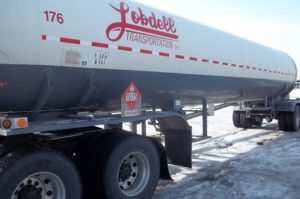Purpose:
The purpose of this article is to identify and explain the regulations of USDOT/PHMSA for the use of a permanent shipping paper to describe a consignment of hazardous materials in transportation by motor vehicle.
Before we Begin:
The Pipeline and Hazardous Materials Safety Administration within the U.S. Department of Transportation (USDOT/PHMSA) creates and enforces the Hazardous Materials Regulations (HMR) for the transportation of hazardous materials (HazMat) in commerce to, from, or through the U.S. by all modes of transportation: motor vehicle, aircraft, railcar, or vessel.
Scope and Applicability:
The regulations addressed in this article apply solely to the transportation of HazMat by motor vehicle within the U.S.
Introduction:
There are some situations where the use of a shipping paper for each shipment of a hazardous material is burdensome and, as it turns out, unnecessary. For example, a company may use its own trucks and drivers to deliver Liquified Petroleum Gas (LPG) to several customer locations in a single day. The driver starts with a large volume of HazMat which declines in volume as deliveries are made at each client site. The hazardous material (LPG) remains the same, the only thing that changes is the reduction in volume.
In the above example, may a carrier use a single shipping paper, without change, for multiple shipments of one or more hazardous materials (assuming each separate hazardous material has the same shipping name and identification number) instead of using a separate shipping paper for each delivery? The answer is yes. Such a document is known as a Permanent” Shipping Paper and is allowed pursuant to 49 CFR 172.201(e):
A motor carrier (as defined in §390.5 of subchapter B of chapter III of subtitle B) using a shipping paper without change for multiple shipments of one or more hazardous materials having the same shipping name and identification number may retain a single copy of the shipping paper, instead of a copy for each shipment made, if the carrier also retains a record of each shipment made, to include shipping name, identification number, quantity transported, and date of shipment.
Like this article? Subscribe to my Monthly Newsletter No marketing emails! |
This interpretation letter from the PHMSA explains further its acceptance of the use of a “Permanent” Shipping Paper based on §172.201(e) (03-0003).
If using a “Permanent” Shipping Paper, the carrier must retain a record of each shipment made. This could be a delivery or billing receipt or some other company-specific document. Pursuant to 49 CFR 172.201(e) the record for each shipment must include the following:
- Shipping name.
- Identification number.
- Quantity transported.
- Date of shipment.
As LOI 03-0003 goes on to explain, the delivery of a partial amount of the hazardous material does not require a change to the “Permanent” Shipping Paper but the pick up of additional quantities of hazardous materials that are not described on the shipping paper does require a modification to the “Permanent” Shipping Paper if the total quantity on the vehicle ever exceeds the amount described on the shipping paper.
Learn More:
- In an earlier article I explained some of the different forms a Shipping Paper may take, such as a Bill of Lading, Uniform Hazardous Waste Manifest, and others.
- In a subsequent article I identified the information that must be included as the hazardous materials description on a shipping paper.
Contact me with any questions you may have about the transportation of hazardous materials by air, highway, vessel, or rail International and Domestic Daniels Training Services, Inc. 815.821.1550 |
Conclusion:
The use of a “Permanent” Shipping Paper could be a great benefit to a carrier who makes a large number of deliveries of the same hazardous material(s). One of the things I enjoy most about training is bringing something like this to the attention of someone in the industry who needs to know. Contact me about my training services and see what you can learn that will benefit you.
Before you Go:
